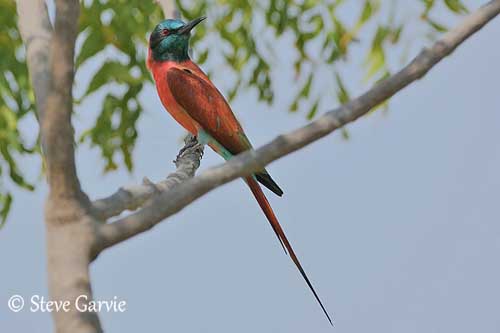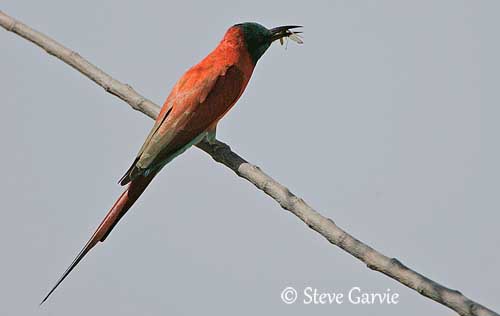
Northern Carmine Bee-eater (M. nubicus)
Fr: Guêpier écarlate
All: Scharlachspint
Esp: Abejaruco Carmín
Ital: Gruccione carminio
Nd: Karmijnrode Bijeneter
Sd: Nordlig Karminbiätare
Southern Carmine Bee-eater (M. nubicoides)
Fr: Guêpier carmin
All : Karminspint
Esp: Abejaruco Carmesí del Sur
Ital: Gruccione carminio dalla gola rossa
Nd: Zuiidelijke Karmijnrode Bijeneter
Sd: Sydlig karminbiätare
Photographers:
Steve Garvie
RAINBIRDER Photo galleries
Callie de Wet
GALLERY
Sources:
HANDBOOK OF THE BIRDS OF THE WORLD Vol 6 by Josep del Hoyo-Andrew Elliott-Jordi Sargatal - Lynx Edicions, 2001 - ISBN: 848733430X
BIRDS OF AFRICA SOUTH OF THE SAHARA by Ian Sinclair and Peter Ryan - Princeton University Press Princeton and Oxford - ISBN: 0691118159
ROBERTS BIRDS OF SOUTH AFRICA by G. R. Mc Lachlan and R. Liversidge – The Trustees of the John Voelcker Bird Book Fuund – ISBN: 0620031182
BIRDS OF THE GAMBIA AND SENEGAL by Clive Barlow and Tim Wacher – Helm Field guides – ISBN: 0713675497
BirdLife International (BirdLife International)
CREAGUS@Monterey Bay (Don Roberson)
Northern Carmine Bee-eater – Merops nubicus
Southern Carmine Bee-eater – Merops nubicoides
Coraciiforme Order – Meropidae Family
INTRODUCTION:
These two similar African species are now raised to the rank of full species.
The Northern Carmine Bee-eater (M. nubicus) is a species living from Senegal E to Eritrea, and S to N Kenya.
The Southern Carmine Bee-eater (M. nubicoides) is found in S Angola, extreme NE Namibia and S Zambia, E to S Malawi and C Mozambique.
Both species migrate but in two different ways.
The Northern Carmine Bee-eater (M. nubicus) spends the austral winter farther S in N Tropics and in E Tanzania.
The Southern Carmine Bee-eater (M. nubicoides) moves northwards to Burundi and S to N Natal, and is rather a local migrant.
These two species are very similar in appearance with only insignificant differences. They are identical in voice, behaviour, ecology and reproduction.
Both species are here described and displayed.
BIOMETRICS:
Northern Carmine Bee-eater (M. nubicus):
Length: 24-27 cm + 9, 5 cm with streamers. Weight: 44-60 g
Southern Carmine Bee-eater (M. nubicoides):
Length: 24-27 cm + 12 cm with streamers. Weight: 10-15% more than previous.


DESCRIPTION:
Both are long-winged bee-eaters.
They have similar body plumage and only differ in head colour and pattern, and general size.
They have carmine upperparts and belly, and azure to olive-green rump and undertail-coverts. The blue colour varies with the light.
On the upperwing, the visible part of the tertial flight feathers is green-blue, and the longest primaries have blue subterminal spot on outer webs. The trailing edge is black. The underwing-coverts are cinnamon-buff.
The tail is carmine with longer central rectrices, named streamers.
On the head, the Northern Carmine Bee-eater (M. nubicus) has greenish-blue forehead, crown, chin and cheeks, and darker olive-green throat. These colours may appear blue, blackish or greenish-blue according to the light. There is a well-defined black mask from lores, through the eye, and becoming broader on the rear eye and the ear-coverts.
The stout bill is black. The eyes are red. Legs and feet are grey.
Both sexes are similar but the female has shorter streamers.
The juvenile is duller, with dull blue crown and forehead, brown nape and upper mantle, and rufous lower mantle. Rump and uppertail-coverts are greyish-blue. The tail is dull carmine with bluish fringes and lacks the streamers. The mask is black.

On the head, the Southern Carmine Bee-eater (M. nubicoides) has similar pattern, except the carmine-pink throat. The eyes are dark brown to black. This species has longer streamers and is larger and heavier than M. nubicus.
Both sexes are similar and the female has shorter streamers.

The juvenile lacks the elongated central rectrices and is duller. It has pale pink (or rarely pale blue) chin and throat. The mask is dull black.

Southern Carmine Bee-eater
Juvenile
VOICE:
Northern and Southern Carmine Bee-eaters utter a loud “terk-terk”. We can also hear a short flight-call “klunk” or “tunk”, or “chip-chip-chip”. The flocks produce harsh twittering “tirriktirrik-tirrik” and loud alarm calls “rik-rik-rik-rak, rak-rik-rak-rik”.
HABITAT:
The Northern Carmine Bee-eater (M. nubicus) can be seen in bushy and wooded savannahs, often near water, rivers and marshes, floodplains with tree patches, pastures with scattered trees, mangroves and grassy plains. It needs riverside cliffs and banks for nesting.
The Southern Carmine Bee-eater (M. nubicoides) frequents woodlands, savannahs and floodplains. It breeds in riverbanks and cliffs along streams.
RANGE: see above “Introduction”

BEHAVIOUR:
Both bee-eaters feed primarily on great variety of insects, and especially grasshoppers and locusts.
They forage in effortless sailing direct flight, but also in wide circles, and they may soar as falcons. They alternate long rests perched in tree with feeding sequences of a few minutes at height of 50-100 metres.

Southern Carmine Bee-eater
Juvenile
They also hunt from perches, chasing a flying prey before to return to the perch where the insect is beaten and swallowed. They may perch on mammals and some large birds too.
They are attracted by bush fires where they pursue the fleeing insects.
They sometimes splash down on to water to catch small fish near the surface, and may occasionally dive in kingfisher-like style.

Southern Carmine Bee-eater
Juvenile
They are gregarious and often forage in small flocks. They roost together at night in large numbers, up to hundreds or thousands of birds.
During the breeding season, they nest in huge colonies on riverbanks and riverside cliffs. They become more vocal while they raise the crown and throat feathers. The quivering tail is fanned and the wings are raised. Courtship feeding from male to female is frequent.

FLIGHT:
Northern and Southern Carmine Bee-eaters hunt while flying straight or in wide circles, and occasionally perform flapping flight. They may soar as falcons and also rise on thermal currents.
REPRODUCTION:
The laying occurs at the beginning of the rainy season at low latitudes, and some weeks before at highest latitudes, between April and June in Nigeria, and September-October in S Africa.
Both species breed in huge colonies. They nest in burrows. They often excavate the tunnels 3-4 months before the laying, at the end of the rainy season, when the soil is still soft and easier to excavate.
They nest in cliffs by rivers, free of vegetation, and sometimes at ground level. The same site is often used for decades.
Both adults excavate the burrow which is straight and slightly declining. With a diameter of about 6 cm and a length between 1 and 2 metres and occasionally 3 and 7 metres. There is an oval nest-chamber at the end, unlined and aligned with the tunnel.

The female lays 2-5 white eggs at about 48 hours intervals. The incubation is shared by both parents and lasts about 3 weeks in captivity. The young are fed by both sexes and fledge 23-30 days after hatching.
The Southern Carmine Bee-eater (M. nubicoides) may have helpers at nest, but any observation of this behaviour in Merops nubicus.
DIET:
Northern and Southern Carmine Bee-eaters feed on numerous species of insects such as grasshoppers, locusts, honeybees and other hymenopterans, water-bugs, wasps, carpenter-bees, dung-beetles, butterflies and cicadas.
The young are fed mainly on large insects.

PROTECTION / THREATS / STATUS:
The populations of both species are threatened by human disturbances and developments, intense use of pesticides, persecution, degradation of rivers and riverbanks, with constant changes in water level and scarcity of preys after poor rainy seasons.
However, they are locally common along rivers throughout their breeding range, and these species are not currently threatened.
